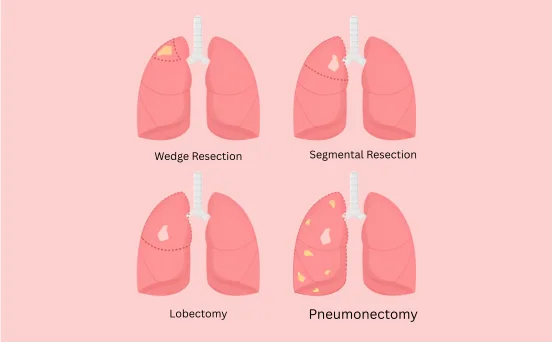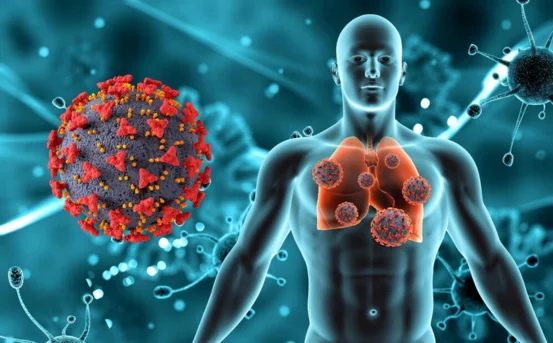The Wedge Resection Surgery is a type of lung surgery in which a small wedge-shaped part of the lung is removed. This is usually done where there is an abnormal growth or lesion. This is a lung sparing procedure as only the affected portion of the lung is removed. The remaining lung remains intact. Wedge resection surgery is performed using video-assisted surgery or robot-assisted methods. It is minimally invasive and requires a shorter hospital stay.
When doctors need to:
- Confirm the diagnosis with a tissue biopsy.
- Small, isolated tumours should be removed.
- Treatment of lung nodules and infections that do not respond to medications
This is an important tool for both diagnosis and treatment, particularly for patients who are not suitable candidates for lung surgery such as lobectomy or pneumonectomy.
Why Is Wedge Resection Surgery Performed
The wedge resection procedure is necessary for a variety of medical and clinical conditions.
- Early-Stage Lung Cancer :- The wedge resection surgery is curative in patients with Stage I NSCLC, especially when the tumors are small and localized. This procedure is especially useful for older patients or those with poor lung function who cannot undergo a full lobectomy.
- Lung Nodules :- When imaging tests reveal abnormal nodules in the lungs, wedge resection surgery can be used to perform tissue biopsy for histopathological evaluation and determine whether or not the nodule has malignant or benign characteristics.
- Metastatic Lung Disease :- Cancers such as breast or colorectal cancer can spread to the lung. The wedge resection can help remove these metastatic lesions and slow down disease progression.
- Infectious lesions or Inflammatory masses :- A wedge resection surgery is the best option for a patient with a localized infection such as a lung infection or fungus that has not responded to antifungal or antibiotic treatments.
- Diagnostic Clarification :- Imaging (CT and PET scans), in some cases, cannot definitively identify the lesion. The wedge resection is a surgical procedure that allows surgeons the opportunity to collect tissue samples for a more precise diagnosis.
Understanding Wedge Resection Surgery and Its Symptoms
Patients may not experience symptoms when abnormalities are discovered during routine scans. In symptomatic cases however, some common signs are:
- Chronic cough
- Blood in the sputum
- Shortness of Breath
- Chest pain
- Unexpected weight loss
- Respiratory infections that persist
- Fatigue and malaise
If these symptoms occur along with suspicious findings on imaging studies, it may be necessary to perform a wedge-resection in order to diagnose and treat the condition.
The Causes of Conditions that Require Wedge Resection
There are many causes for the need to wedge resection, including:
- Primary lung cancer is caused by smoking or genetic predisposition.
- Secondary or metastatic cancers that originate in other organs
- Hamartomas and other benign tumors
- Chronic infections (e.g. tuberculosis and fungal infections).
- Inflammatory conditions
- Congenital anomalies in lung structure
- Effective treatment requires a thorough understanding of the root cause.
Diagnosis before Wedge Resection Surgery
Doctors perform a thorough diagnostic evaluation before recommending wedge resection to determine the extent of lung lesions and the overall health status. These include:
- Image Tests
- Chest X ray: First tool to detect any abnormal mass or shadow.
- CT (Computer Tomography) scan: Provides an image of the lung tissue and nodules.
- PET Scan is used to detect metastatic cancer or cancerous activity.
- Pulmonary Function Tests :- The tests are used to determine if the patient is able to tolerate surgery.
- Blood Test & Biomarker Analyses :- Regular blood tests and tumor markers can help determine your overall health as well as any signs of cancer.
- Needle biopsy or Bronchoscopy :- Doctors may first try less invasive methods of biopsy before resorting wedge resection. Treatment: Wedge Resection Surgery. Two main methods can be used to resection a wedge:
- Video-Assisted Thoracoscopic surgery (VATS)
- This minimally-invasive technique inserts a camera and special instruments through small incisions. It is the gold standard because:
- Postoperative pain is reduced
- Shorter hospital stay
- Recovery time is faster
- Fewer complications
- Open Thoracotomy:- Traditional approach using a large incision with rib spreading. When:
- The tumor is located in an area that is difficult to access
- The dissection of the fetus is extensive.
Surgical Process Overview:- The patient is put under general anesthesia.
- The surgeon inserts the thoracoscope camera through small incisions.
- Using surgical instruments, a wedge-shaped section of lung tissue is removed.
- To confirm the diagnosis, the tissue is sent to a biopsy.
- The incisions and lung are then closed.
Postoperative Care & Recovery:- Patients are monitored in the hospital from 2 to 5 days after surgery depending on their surgical approach. Tips for recovery include:
- Deep breathing exercises
- Strengthening your body through physical therapy
- Pain Management
- Avoid strenuous activities for a couple of weeks
- Follow-up imaging review and pathology
Conclusion
The wedge resection is an effective and safe surgical procedure for the removal of small, localized lung anomalies. This procedure is a minimally-invasive option that has high success rates, whether it’s used for cancer treatment or infection control.
This procedure not only preserves the lung function, but it also improves recovery chances for patients without the need to remove major lung tissue. Consult a thoracic specialist if you or someone close to you has been diagnosed as having a suspicious lesion on the lung.























